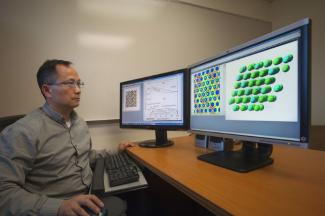NETL leverages its expertise in computational modeling to advance the design and improve the capability to predict the performance of alloys in harsh environments needed to reduce the environmental impact of energy production.
Several studies by researchers at the Lab and others affiliated with the NETL-led eXtremeMAT consortium, which focuses on developing next-generation computational models for design and performance prediction of alloys in extreme operating conditions, are featured in a special edition of JOM, The Journal of The Minerals, Metals & Materials Society devoted to computational design of alloys for energy technologies.
Affordable, durable alloys that can withstand harsh conditions play a critical role to support decarbonization of the energy sector. Such materials can withstand degradation and embrittlement when exposed to hydrogen under complex loading conditions (such as cycling) for long service times.
Increasing the pace of material discovery to advance clean energy technologies is essential. To date, alloy development has been a time-consuming process marked by repeated tests to achieve the desired component performance. Computational modeling and the development of simulation data represent the next step to close the design loop for rapid alloy development.
The studies selected for publication focus on the use of computational tools to provide validated models capable of simulating and predicting long-term performance and failure mechanisms of newly developed materials with specific emphasis on durability, availability and cost. Studies by NETL researchers published in the journal’s special edition include:
· Ab Initio Study of Energetics, Charge Transfer, and Atomic Structures of FCC Fe/NbC Interfaces with and Without N Doping: From Coherent to Semi-coherent Interfaces. NETL researcher Michael Gao and co-authors at the Idaho National Laboratory examined how nitrogen, which is added to stainless steels to improve their corrosion resistance, may impact the precipitate/matrix interfacial properties. The work offers insights for precipitation modeling and is relevant to the computational determination of the service life of complex alloys.
· Adversarial Ensemble Modeling of Multi-modal Mechanical Properties for Iron-Based Alloys. To ensure the desired performance of stressed components, it is important to understand the origin and mechanisms of such behavior. NETL researcher Vyacheslav Romanov introduced adversarial ensemble modeling to explain the multimodal mechanical properties of iron-based alloys.
· A Phase-Field Study on Internal to External Oxidation Transition in High-Temperature Structural Alloys. NETL’s Rui Wang, Tianle Cheng, Fei Xue and You-Hai Wen collaborated with researchers at Pennsylvania State University to study how dispersed metal oxide particles reach the surface of reactive alloy components to form a protective scale.
· Concurrent Precipitation of Nb(C,N) and Metastable M23C6 in Alloy 347H at 700°C and 750°C: Computer Simulations and Comparison to Experiment. Researchers from several national laboratories, including NETL’s Michael Gao, conducted precipitation simulations on alloy materials.
NETL is a U.S. Department of Energy national laboratory that drives innovation and delivers technological solutions for an environmentally sustainable and prosperous energy future. By leveraging its world-class talent and research facilities, NETL is ensuring affordable, abundant and reliable energy that drives a robust economy and national security, while developing technologies to manage carbon across the full life cycle, enabling environmental sustainability for all Americans.
Top: NETL’s Michael Gao uses computational simulation software to develop a unique set of databases that will help NETL create higher-performing alloys in advanced energy systems.




